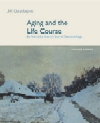1. The National Institute of Health Research (http://www.nihr.org)
has summarized the elderly's attitudes toward assisted suicide, as reported
in a recent Gallup Poll. Go to the institute's website and on the homepage,
type "assisted suicide" in the search bar. Read the article titled
"Elderly Oppose Legalizing Assisted Suicide" and answer the following
questions: a. How many senior citizens were polled? What was their average age? b. How did the respondents feel about legalizing assisted suicide? c. What was the greatest predictor of respondents' opposition to legalizing
assisted suicide? d. What group showed the most lenient attitude toward suicide? e. Which older persons were more likely than others to feel that suicide was
a personal decision? 2. The American Association of Retired Persons (http://www.aarp.org)
is a nonprofit, nonpartisan organization dedicated to shaping and enriching
the experience of aging. To find statistical information on widowhood in the
United States, go to the AARP's web page and type "widowhood" in the
search bar. Read the article titled "Coping with Grief and Loss: Statistics
about Widowhood" and answer the following questions: a. What is the average monthly Social Security benefit for a widow(er) in the
United States? b. Look at the table. How many women age 65–75+ became widows during 1995? c. How many men age 65-75+ became widowers during the same period? d. What percentage of persons aged 65 and over live alone in the United States
today? e. How many widowed people live in the United States? f. How many widowed people in the United States are women? 3. The Children, Youths, and Family Consortium located at the University of
Minnesota (http://www.cyfc.umn.edu/Documents/H/I/HI1003.html)
provides information involving the death of a parent. Read "Grief upon
Death of Parent," and answer the following questions: a. How did the researchers find subjects for the study? What criteria
had to be met? b. In what way did the death of the parent affect the adult child? c. What five factors were associated with the variance in residual grief
following the death? d. What is the purpose of this ongoing study? 4. Euthanasia.com (www.euthanasia.com)
is a web site that provides information for research on euthanasia, physician-assisted
suicide, living wills, and mercy killing. Go to the site and click on "Start
Here for Introductory Information on Euthanasia and Assisted Suicide."
Then click on the article, Euthanasia—Frequently Asked Questions. Then
answer the following questions: - What is euthanasia, and why is it different than assisted suicide?
- Why are there laws against euthanasia?
Go back to the homepage and click on "Medical." Read the article
"Cancer Specialists' Support for Assisting Suicide, Euthanasia Drops
by Half in Four Years." Answer the following question: - Which doctors were less likely to perform euthanasia or physician-assisted
suicide?
| 


 2002 McGraw-Hill Higher Education
2002 McGraw-Hill Higher Education